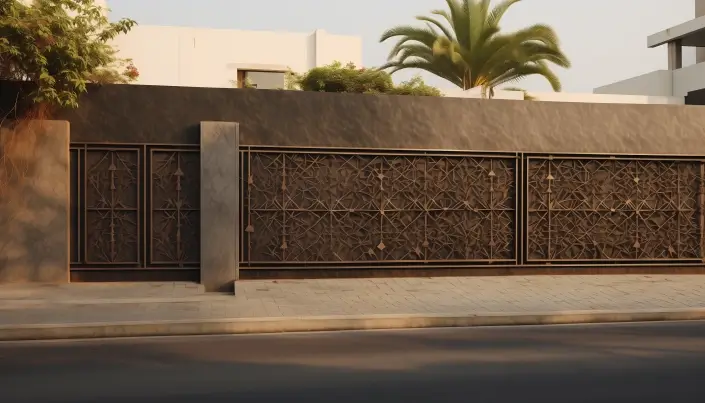concrete boundary wall design | stone | PVC | metal | brick | bamboo | grills
In many parts of the world, boundary walls are a popular choice for separating property. These structures have two purposes: to protect property and maintain the privacy of the home inside. Indian homeowners have found that boundary wall designs can serve both purposes.
Here are some of the main options for boundary walls. Read on to learn more about their benefits. You may be surprised to learn that a simple boundary wall design can also be very beautiful!
1. Boundary Wall Design: Concrete
The most common material for a boundary wall is concrete, bricks, or stone. The choice of material depends on the overall style and design of the house. For an outer wall, these materials can be used separately or in combination to give the best effect.
Clay bricks are the cheapest option, and they are durable, easy to build, and fire resistant. But they can also be easily damaged and splintered. Bricks are also more versatile and stronger when they are coated with cement or paint.
Another option for a boundary wall is wood. A wooden panel can look beautiful and last for a long time, but it will not be as durable as a concrete wall. Unlike concrete, wooden panels are easy to maintain and can be made from a variety of materials.
You can also opt for a metal compound wall, which combines both concrete and metal. These materials are durable and can withstand high wear and tear.
Another option for a boundary wall design for Indian homes is precast concrete. These walls are manufactured in a factory and transported to the construction site. These are the ideal choice for residential boundary walls.
They are less expensive than masonry wall construction, yet still, give off a modern compound wall design. Most of these types of walls are used in cantonment areas and military bases, but common homeowners can also opt for them if they are able to afford them.
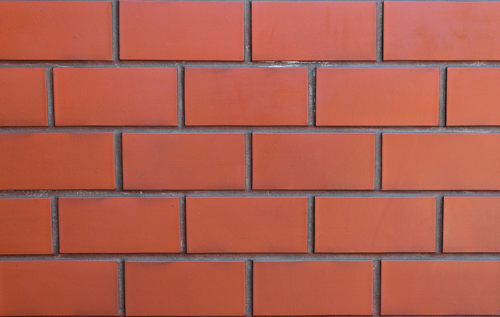
2. Boundary Wall Design: Stone
Natural stone is a perfect material for exterior construction. It has many advantages:
- Stone is durable and low-maintenance.
- It is available freely in nature and has several advantages over other materials.
- Stone can be used for a range of applications, from walls to floors and even for furniture.
- Also, it does not produce waste and contributes less to environmental pollution.
- Its unique textures and color variations make it an ideal choice for outdoor construction.
Unlike other materials, stone does not need treatment or purification before it can be used as a boundary wall. It also doesn’t need to be heated or baked before it can be used. The manufacturing process for stone results in very little waste.
It has a high rate of utilization and recycling, meaning it will never end up damaging the Earth in the process. Moreover, when used for building, the stone can be recycled and used for other purposes, such as road construction or artwork.
Natural stone is a natural product taken from quarries located in the lap of the earth. Stone has been used for centuries as a building material.
Nearly all civilizations have used stone in some form. With plenty of varieties in every part of the world and on each layer of the earth’s crust, stone has a long history of use. The material is dense, durable, and resistant to wear and damage.
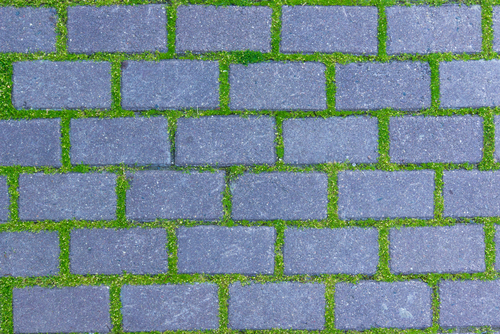
3. Boundary Wall Design: PVC
For people looking for low-maintenance materials for boundary walls, PVC is a perfect choice. This material is incredibly lightweight and consists of multiple layers. Each panel is sandwiched between two PVC sheets, providing strength while remaining lightweight.
The panels are interlocked to prevent water from seeping through the joints. In addition to the interlocking system, PVC panels also feature grooves that give them a stripe-like appearance, which hides any joint.
While wooden boundary walls can have innumerable designs, they cannot withstand the extreme weather conditions of India. For this reason, PVC is a fantastic choice for boundary walls in Indian homes.
It is highly durable and does not require painting or maintenance and is attractive at the same time. PVC boundary walls also last for decades, making them a great choice for those who do not want to spend a lot of money on fences.
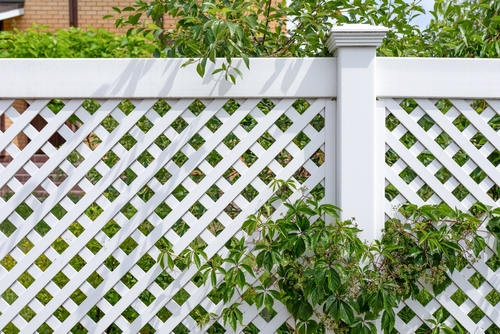
4. Boundary Wall Design: Metal
There are many options for your boundary wall design. Wooden panels are an attractive option but may not be durable enough to last a decade or more. Metal compound walls, on the other hand, are cost-effective and all-weather.
These walls can be painted every two years in any color and are a great option for Indian homes. There are also no limits to the design possibilities when it comes to metal.
Another affordable option for your boundary wall design is the use of pebbles or large boulders. Boulders can be positioned in an attractive manner with cranes. Pebbles and rocks can be painted to give them a more decorative look.
You can also add flower beds to add aesthetic appeal to your boundary walls. You can also opt for decorative screens incorporated into a solid wall structure. These screens can be combined with special metalwork, laser-cut graphics, ambient lighting, and decorative screens.
While choosing a material for your boundary wall, be sure to consult your neighbors. If you have a neighbor, they may want to share the cost of construction. Ask them if they’d like to have a say in the design.
Also, consider the height of the boundary wall. You’ll want it high enough to prevent burglars from jumping over it. Also, keep in mind your neighbor’s landscaping and trees to avoid causing a disturbance to them.
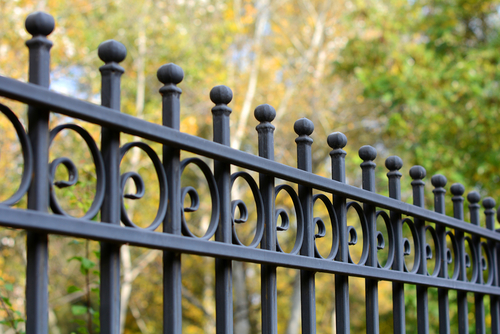
5. Brick
As Indians spend a lot of money on their homes, the boundary walls have also become quite important. Not only do these walls provide the necessary fortification for a house, but they are also very stylish and can add a lot of greenery to the boundary.
Brick is an excellent choice for boundary walls. Brick is one of the most common building materials in India and the design of the boundary walls can be done in many different ways.
When choosing the style and materials for the boundary wall, make sure that you consider your gate and how you would like it to look. You don’t want it to be too high or too low, so it is important to think about the gate design first.
Once you have decided on the style of the gate, you can start and end the boundary wall design at the gate. Wooden and stone boundary walls have many advantages.
A boundary wall is an integral part of a house’s exterior, so its height of it should be appropriate for protecting the house. It should also have sufficient height to minimize street noise and pollution.
To help you decide what type of boundary wall you want, check out boundary wall pictures. By researching these photos, you can find ideas for boundary walls that fit your home’s style and budget.
There are many other ways to protect your property, so don’t forget to choose an attractive and safe boundary wall design.
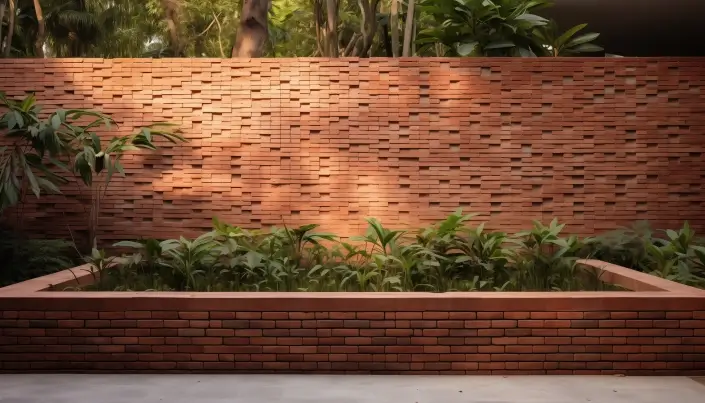
6. Bamboo
There are many reasons to build your boundary walls with bamboo. Bamboo is extremely strong and durable, with a weight-to-strength ratio that rivals steel. It can also be used in structural applications, replacing 70 percent of steel in construction.
As an added bonus, bamboo is also a carbon-capture material. As a result, it can help slow down climate change and reduce energy bills.
The most obvious advantage of bamboo is its durability. It can withstand extreme changes in humidity and temperature. It also offers a warm, inviting aesthetic. And, while you can buy bamboo in its natural state, it can be stained, finished, or shaped to match your home’s aesthetics.
Bamboo can be used as an exterior boundary wall or to enclose less important spaces. However, it is important to maintain its structural integrity for decades to come.
Another advantage is that bamboo is edible. The shoots can be cooked or eaten raw. They are available at supermarkets in sliced and canned versions. Because bamboo is so resilient, it can withstand severe weather conditions, even a small amount of decay can change its capacity.
It is important to note that bamboo culms do not grow as tall as timber. Moreover, they do not get taller or wider than they are today.
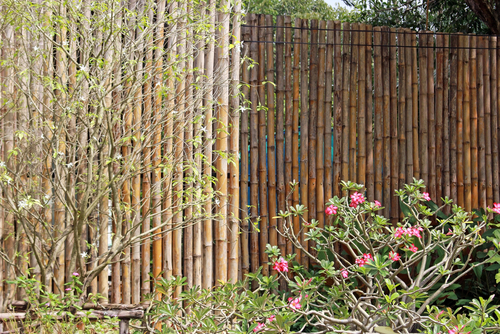
7. Compound wall design with grills
A compound wall with grills can be very attractive and secure. They give the feel of a rustic old country house. Stones are used to filling in the spaces between the iron grills and nets. A modern architecture style uses random geometric shapes for compound walls.
These designs can give a stylish and unique look to your home. The design can also be customized to suit your needs. In this way, you can choose from a large variety of designs for your compound wall.
The compound wall design with grills can be used for any home. It doesn’t take much effort, since the steel sheets cover the upper part of the iron net boundary. Another way to create an appealing compound wall design is by painting it.
Paint it with a single color or a multi-color palette. You can also paint the lamp posts to match the design. It’ll make the compound wall look more appealing to the eye.
Compound walls are often constructed after the main building is completed. But this procedure is not always ideal. If you have an existing compound wall on the property, you should upgrade it based on the Vastu principles.
For instance, in India, it’s best to build a compound wall with pillars on three sides, rather than one. If the wall isn’t parallel with the house, it won’t add to its street appeal.
